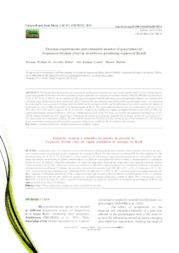Thermal requirements and estimated number of generations of Neopamera bilobata (Say) in strawberry-producing regions of Brazil.
Thermal requirements and estimated number of generations of Neopamera bilobata (Say) in strawberry-producing regions of Brazil.
Autoria: KUHN, T. M. de A.; LOECK, A. E.; BOTTON, M.
Resumo: The thermal threshold and thermal requirements of Neopamera bilobata were determined, and the number of generations that this species may produce in the main strawberry-producing regions of Brazil was estimated. In a climate chamber (70±10% RH and 12h photophase) at 16, 19, 22, 25, 28, or 30±1°C, the development of 120 eggs was monitored until the adult stage, at each temperature. Nymphs were maintained in individual cages and fed on strawberry fruits of the cultivar Aromas. The mean duration and viability of the egg and nymph stages were calculated by estimating the lower and upper developmental thresholds and the thermal constant, and this information was used to estimate the number of generations per year in different strawberry-producing regions of Brazil. The egg-to-adult duration decreased as temperatures increased, up to 28°C (93.4, 83.2, 43.9, and 31.4 days at 19, 22, 25, and 28°C, respectively). Viability of nymphs was highest between 22 and 28°C. At 30°C, the egg-to-adult duration increased (36 days), while the viability decreased (11.11%). The lower egg-to-adult developmental threshold was 15.2°C and the thermal constant was 418.4 degree-days. Calculating the number of generations indicated that the largest number (5.1 generations yr?1) was obtained for the municipality of Jaboti, Paraná, and the smallest for Caxias do Sul, Rio Grande do Sul (1.9 generations yr?1). Our findings demonstrated that important strawberry-producing regions in Brazil are suitable for the development of N. bilobata. Key words: environmental factors, thermal requirements, predictive models.
Ano de publicação: 2017
Tipo de publicação: Artigo de periódico
Unidade: Embrapa Uva e Vinho
Observações
1 - Por padrão são exibidas publicações dos últimos 20 anos. Para encontrar publicações mais antigas, configure o filtro ano de publicação, colocando o ano a partir do qual você deseja encontrar publicações. O filtro está na coluna da esquerda na busca acima.
2 - Para ler algumas publicações da Embrapa (apenas as que estão em formato ePub), é necessário ter, no celular ou computador, um desses softwares gratuitos. Sistemas Android: Google Play Livros; IOS: iBooks; Windows e Linux: software Calibre.
Acesse outras publicações
Acesse a Base de Dados da Pesquisa Agropecuária (BDPA) para consultar o acervo completo das bibliotecas da Embrapa.

